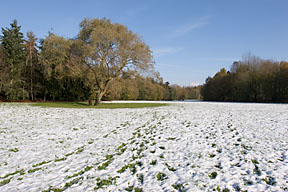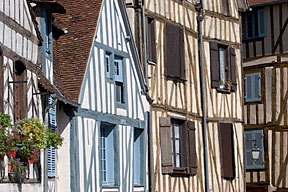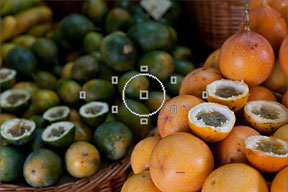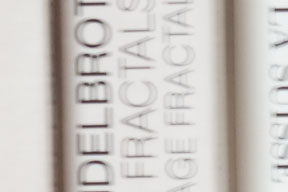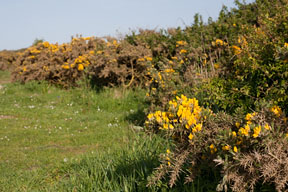You will find here a few tips to help with some of the questions that spring up just before shooting…
Suggesting motion
Movement may be suggested by longer exposures. Here are a few suggestions that you'll need to adjust with your actual subject:
- at least 1/15 s for running water,
- 5 s or more for moving car lights,
- 1/4 s for moving hands (pointing, writing, etc.),
- 1 s for leaves in the wind.
Exposure compensation
With a digital SLR, it is easy to inspect the histogram, adjust exposure and shoot again. But, let's not forget the good habits... Here are a few orders of magnitude that will help you adjust exposure according to a specific zone of your composition and the area covered by the metering mode (single autofocus point evaluative, partial or spot):
- Very bright +2 EV,
- Bright +1 EV,
- Average +0 EV,
- Dark -1 EV,
- Very dark -2 EV.
This is very useful in single autofocus point evaluative metering, as both exposure and focus are memorized when triggering halfway. This is not the case in partial or spot metering, where you need to use the * key to memorize exposure before recomposing and triggering.
For this image, one can aim towards the foliage and expose at -2/3 EV (relatively dark) or aim towards the snow and expose at a bit more than +1 EV (quite bright) or even aim towards the sky and expose at +2/3 EV as it is slightly veiled (a pure blue sky should be exposed at 0 EV).
RAW vs JPEG
I use RAW mode when precise exposure or white balance is essential, and will probably benefit from Photoshop Camera RAW adjustments: landscapes, architecture, macro-photography, artificial light...
I use JPEG mode (at its highest quality) when capturing the instant is more important than the actual perfection of the image: sports, moving people & animals... In this configuration, the camera buffer can hold longer shooting bursts. Roll your mouse over the image to visualize the best picture selected from a set of 270 taken in 20 minutes.
Midday photography
It is well known that the early morning will give you the most beautiful lights. Nevertheless, when the sun is at its highest and the shadows too contrasted, it is still possible to make some good shots:
- prefer evenly lit semi-detail,
- fill-in flash can help wash out nearby shadows (portraits for instance),
- use RAW file format to keep as much dynamic range as possible for post-processing,
- the polarizing filter can also help reduce bright 90° reflections; in this case, you will need to slightly warm up the color temperature under Photoshop.
This evenly lit semi-detail image was taken around noon. Rolling your mouse over it will reveal a softened version (Camera RAW).
Sunsets
When shooting sunsets, Auto White Balance averages the colors. You should select a "daylight" white balance to recover the actual colors. Concerning exposure, a partial metering just besides the sun is usually right on (0 EV).
This image has an auto white balance color temperature, roll your mouse over it for daylight white balance.
Focus Recompose
The EOS 5D Mark II autofocus points being too centered, I frequently use the very efficient centre point for focusing (shutter button halfway), further recomposing before fully triggering. The
measured distance error is not really significant until a distance of less than 2 m (6 ft) at f/2 or 1 m (3 ft) at f/4 for a subject at the thirds on a FF sensor. In this case, and to avoid any measurement error, I use a lateral autofocus point while recomposing by rotating the camera around the sensor centre axis.
Rolling your mouse on the image will illustrate such a focusing phase.
In low light, the flash in autofocus assist mode without firing may help a lot for precise focusing.
Statistical Stabilizer
To fully benefit from the EOS 5D Mark II's 21 MPixels, you need to double or triple the old film rule of thumb of 1/focal speed. With a still subject at slow speed, a burst will help reduce motion blur by choosing the best shot (the first image is always blurred because of finger motion). I generally observe a 2 to 3 EV gain with 5 to 9 images bursts. Therefore, I don't miss
IS too much on my prime lenses, even though IS remains very useful to stabilise the viewfinder image or for greater depth of field without a tripod.
This is a 100% crop of the first image at 50 mm and 1/10s. Rolling your mouse will reveal the sharpest of the burst of 9.
3D: depth of field
After 4 years in APS-C, I finally recovered depth of field control with the EOS 5D Mark II full frame format. This is especially noticeable with light fast prime lenses like the "normal" 50 mm f/1.4.
A low contrast composition where the subject is lost in the background may become interesting with a shallower depth of field (perspective suggested through sharpness gradations between foreground, subject and background).
Roll your mouse on this 50 mm f/10 image for an f/1.4 version.


